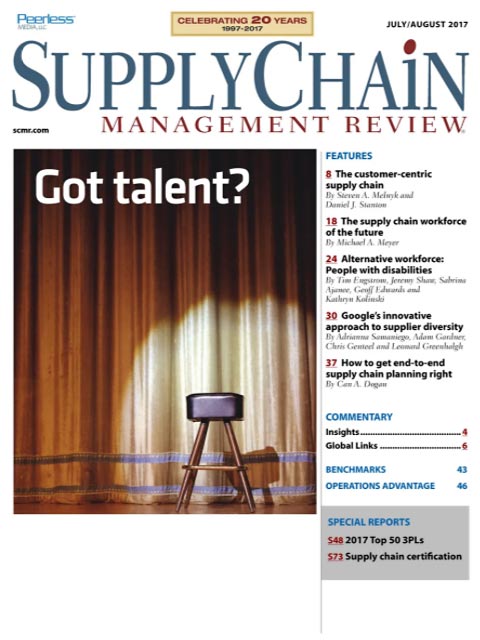Sorry, but your login has failed. Please recheck your login information and resubmit. If your subscription has expired, renew here.
July-August 2017
A few years ago, a Harvard Business Review cover posed the question: What’s the secret to winning in the global economy? The answer: Talent. Browse this issue archive.Need Help? Contact customer service 847-559-7581 More options
I believe that planning and forecasting processes are cerebral, and in effect are both the brain and the heart and soul of a company’s strategic business model. Managers that participate in these processes are usually the smartest and most analytically minded in a company. Therefore, these processes should be outsourced very minimally—if at all.
However, I’ve recently had a couple of conversations about companies that are experimenting with partially outsourcing their demand forecasting processes to external consultants. Apparently these companies want to leverage Big Data to forecast customer demand and are having a difficult time finding, hiring and keeping “data scientists.”
Generally, I believe demand forecasting needs to be done internally for effective and efficient integration with planning processes such as sales and operations planning (S&OP). More importantly, it should be kept in-house for competitive and financial disclosure reasons. I would be less concerned with outsourcing some of the mechanistic aspects of running complex computer systems that support purely statistical forecasting processes. For example, generating the baseline forecast is an initial statistical forecast based just on historical demand data. (The baseline forecast is adjusted for factors such as future sales and marketing activities to collaboratively come up with finalized consensus-based demand forecasts.)
The forecasting process
A company’s S&OP team needs to work collaboratively with a professionally run and independent forecasting organization.* Forecasters and planners must work hand-in-hand to help a company navigate toward corporate financial objectives. However, because forecasters must be unbiased, they should be not be subject to the pressures involved in demand achievement. Their main job is to develop quantitative forecasts (often weekly and monthly) based on marketing and sales activities, as well as other factors that affect future demand. This requires continual collaboration among forecasters and marketing and sales management. And, this collaboration should not be outsourced to external consultants.
There are various ways to organize a forecasting function. Some companies have a single centralized forecasting organization, while others have forecasters distributed throughout them, for example among business units. The latter sometimes has a “center of excellence” group that supports the distributed forecasters. Centralized forecasting departments and centers of excellence might report into any of a company’s functional departments.

This complete article is available to subscribers only.
Log in now for full access or start your PLUS+ subscription for instant access.
SC
MR
Sorry, but your login has failed. Please recheck your login information and resubmit. If your subscription has expired, renew here.
July-August 2017
A few years ago, a Harvard Business Review cover posed the question: What’s the secret to winning in the global economy? The answer: Talent. Browse this issue archive. Access your online digital edition. Download a PDF file of the July-August 2017 issue.I believe that planning and forecasting processes are cerebral, and in effect are both the brain and the heart and soul of a company's strategic business model. Managers that participate in these processes are usually the smartest and most analytically minded in a company. Therefore, these processes should be outsourced very minimally—if at all.
However, I've recently had a couple of conversations about companies that are experimenting with partially outsourcing their demand forecasting processes to external consultants. Apparently these companies want to leverage Big Data to forecast customer demand and are having a difficult time finding, hiring and keeping “data scientists.”
Generally, I believe demand forecasting needs to be done internally for effective and efficient integration with planning processes such as sales and operations planning (S&OP). More importantly, it should be kept in-house for competitive and financial disclosure reasons. I would be less concerned with outsourcing some of the mechanistic aspects of running complex computer systems that support purely statistical forecasting processes. For example, generating the baseline forecast is an initial statistical forecast based just on historical demand data. (The baseline forecast is adjusted for factors such as future sales and marketing activities to collaboratively come up with finalized consensus-based demand forecasts.)
The forecasting process
A company's S&OP team needs to work collaboratively with a professionally run and independent forecasting organization.* Forecasters and planners must work hand-in-hand to help a company navigate toward corporate financial objectives. However, because forecasters must be unbiased, they should be not be subject to the pressures involved in demand achievement. Their main job is to develop quantitative forecasts (often weekly and monthly) based on marketing and sales activities, as well as other factors that affect future demand. This requires continual collaboration among forecasters and marketing and sales management. And, this collaboration should not be outsourced to external consultants.
There are various ways to organize a forecasting function. Some companies have a single centralized forecasting organization, while others have forecasters distributed throughout them, for example among business units. The latter sometimes has a “center of excellence” group that supports the distributed forecasters. Centralized forecasting departments and centers of excellence might report into any of a company's functional departments.
 SUBSCRIBERS: Click here to download PDF of the full article.
SUBSCRIBERS: Click here to download PDF of the full article.
SC
MR


Latest Supply Chain News
- How CPG brands can deliver on supplier diversity promises
- How S&OP provides the answer to in-demand products
- AI, virtual reality is bringing experiential learning into the modern age
- Humanoid robots’ place in an intralogistics smart robot strategy
- Tips for CIOs to overcome technology talent acquisition troubles
- More News
Latest Podcast

 Explore
Explore
Procurement & Sourcing News
- How CPG brands can deliver on supplier diversity promises
- How S&OP provides the answer to in-demand products
- There is still work to do to achieve supply chain stability
- Blooming success: The vital role of S&OE in nurturing global supply chains
- How one small part held up shipments of thousands of autos
- Shining light on procurement’s dark purchases problem
- More Procurement & Sourcing
Latest Procurement & Sourcing Resources

Subscribe

Supply Chain Management Review delivers the best industry content.

Editors’ Picks





